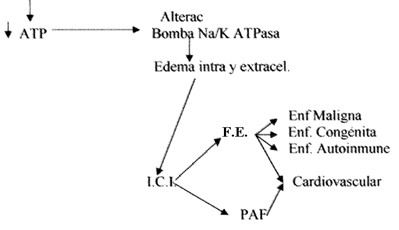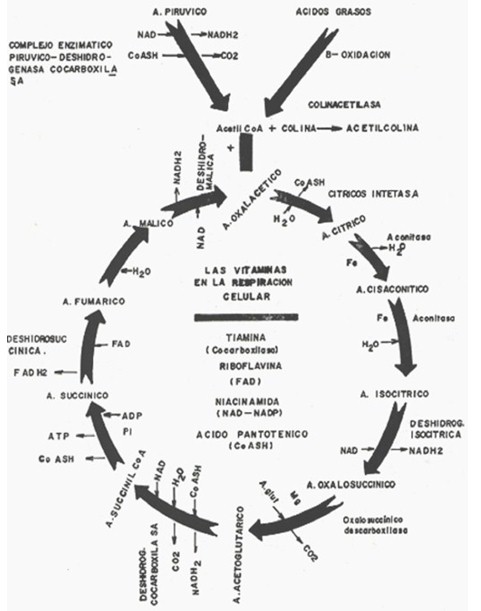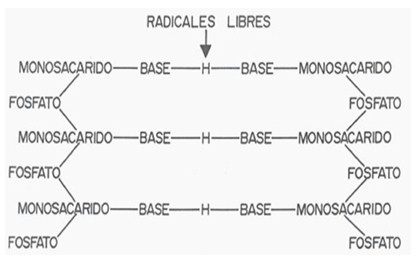|
Factores de riesgo y enfermedades no transmisibles .6
7- Las mitocondrias también comparten el edema intracelular en el proceso de la Inflamación Crónica Inespecífica. La persistencia de la acción inflamatoria va a determinar una lesión permanente de peroxidación de los FE sobre la misma mitocondria a nivel de las crestas y matriz donde se realizan las reacciones del ciclo de Krebs y la fosforilación oxidativa. De esa forma, la mitocondria pierde su capacidad degradativa de la glucosa, por lo que esta aumenta en el plasma, dando lugar a la Diabetes-2, insulino-resistente que aparece en la vida adulta al fundirse la central eléctrica, la mitocondria. Ahora, no se trata propiamente de una resistencia a la insulina, sino que se han fundido los fusibles donde se metaboliza la glucosa para producir la energía.
FACTORES DE RIESGO
1. Déficit de vitaminas del complejo B
2. Diabetes
3. Alcohol
4. Tabaco
5. Cocaína
6. Herbicidas

Figura 1.

Figura 2.

Figura 3.
BIBLIOGRAFÍA
1- Cotran, R.S. et al. –Patología Estructural y Funcional. 5ª. Ed. Mc-Graw-Hill Interamericana, Madrid, 1997.
2- Guyton, A.C. et al. –Tratado de Fisiología. 9ª. Ed. Mc-Graw-Hull Interamericana, México, 1997.
3-Altamar, J. –Herbicidas y Malf. Congén. en el Meta, Colombia. Actividad Patogénica de los radicales libres (RL). Orinoquia, Villavicencio, Colombia, 2002; 6: 5-35
4- Villa Pérez, M. –radicales libres (RL) de oxígeno (O2) y la Enfermedad. Conferencia en la VI Reunión del Grupo Español RL. Cádiz,
5- Jiménez, S. –Antioxidantes y radicales libres (RL) en el Tabaquismo. Solo-Mujeres. Buenos Aires; 2003.
6- Southern, P.A. and Powis, G. –Medicine. II. Involvement in Human Disease. Mayo Clinic.Proc.1994; 63: 390-404.
7- Altamar, J. –El Síndrome de Sjögren, una manifestación de deficiencia del complejo B. Anales ORL-Iber-Amer: 1985; 12: 443-457.
8- Green, P.H.R. –Alcohol Nutrition and Malabsort. Cl.Gastroen.N.A. 1983; 12: 563-574.
9- Lemoyne, P. et al. –Les enfants de parens alcoholiques. Anomalies observes. Quest. Med. 1968; 21 : 476-482.
10- Jones, K.L. –Pattrerns of malformation in offspring of chronic alcoholic mother. Lancet. 1973; 1:1267-1271.
11- Palmer, R.H. et al. –Congenital malformation on offspring of a chronic alcoholic mother.Pediatrics, 1974; 53:490-494.
12- Falcón, G. Et al. –Síndrome alcohólico fetal. Rev.Esp.Ped. 1980; 36: 35-42.
13- Ruiz, M. Et al. –Efectos tóxicos del tabaco. Rev.Toxicol. I.Canarias. 2004; 21:47-71.
14- Goodman y Gillman, L.S. –Bases Farmacologicas de la Terapéutica. 8ª. Ed. Edit. Panamericana, México, 1991.
15- De Ross, A. J. et al. –Cancer incidente among Glyphosate-Exposed Pesticida Applicators in the Agricultural Health Study. Enviromental Health Perspective, 2005; 113: 4957.
16- Ramírez D, W.F. et al. –Efectos del Glifosato con énfasis en organismos acuáticos. (Revisión de Literatura). Orinoquia, Villavicencio, Colombia, 2004; 7:70-100
17- Martins, M.A. et al –Interaction between inflammation and systemic haematologic Effect of PAF- acether in the rat. L.Pharmacol. 1989; 36: 333-360
18- Hilliguin, P. et al.-Correlation. Between PAF-acether and tumor necrosis factor in rheumat Arthritis. Influen. Of parenter-corticoter. Scands. J. Rheumat. 1995; 24: 169-173.
19- Hollan, S. –FR in health and diseases. Haematologia. Budapest, 1995; 26: 177.
20- Alloati, G. Et al. –Role of PAF in oxygen radical.induced cardiac dysfunction. J. Pharmacol.Exp.Ther. 1994; 269: 766-771.
21- Altamar, J. –La Parotiditis recidivante. Su etiopatogenia y tratamiento. Anales ORL. Iber-Amer. 1994; 21: 391-402.
22- Hallivell, B. –Current review. Free reactive oxygen species human disease, a critical evaluation with special Reference to atherosclerosis. B. Exp. Path. 1995; 70:737-771.
23- Lane, D.P. and Crawford, l.V. –SV40 T antigen is bound to a host protein in V40 transformed cells. Nature (1979); 278: 262-263.
24- Richard, J. –Fumar. Cigarrillo. Reduce los niveles del antioxidante paraoxonasa. Diario Médico, mayo 2000.
25- Narayan, A. et al. –Dissimilar cell cicle responses alter y-irradiation and cisplatin. Treatment are induced by p53 in head and neck squamous cell carcinomas. In Lppert-Metast. in Head and Neck Cancer. Proc. In 2nd Intern. Symposium. January 25-27, 2001. Marburg, Germany.
26- Mochon, A. et al. –La mutación p53: un fenómeno tardío en la oncogénesis de cabeza cuello. Anales ORL.Iber-Amer. 1998; 25:433-771.
27- Bier, H. et al. –Assesment of p53 mutations in squamous cell carcinomas of the head and neck: the critical impact of applied methods In Lippert, -Metastases in Head and Neck Cancer. Proceed. of the 2nd International Symposium. January 25-27, 2001, Marburg, Germany.
28- Gottschlich, S. et al. –p53 gene analysis cancer of unknown primary in the head and neck. In Lippert, BM. Metastases in Head abd Neck Cancer. Proceeding of the 2nd Intern. Symposyum. January 25-27, 2001, Marburg, Germany.
29- Altamar, J. –The role of Lysozime on etiopathogenesis and treatment on Juvenile laryngeal papillomatosis. Otolaringol. Torino, Italy; 1998; 44: 17-22.
30- Altamar, J. –Acalasia esofágica y mongolismo, papilomatosis laríngea y dermatomiositis. ¿Un origen común? Revisión. Anales ORL-Iber-Amer, 1997, 24: 551-562.
|